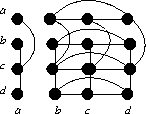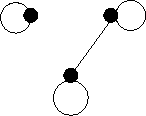
|

|

|

|
Applying the Sequence Theorem (2.10), this sequence is graphical if and only if
s1: 2, 2, 2, 2, 2, 2, 1, 1 is graphical.
s1 is the degree sequence of the path P8.
So the final answer is P8 with an extra vertex joined to
five of the internal degree 2 vertices of the path.
Applying the Sequence Theorem (2.10), this sequence is graphical if and
only if
s1: 4, 4, 3, 2, 1, 0 is graphical.
Again applying the Sequence Theorem (2.10) again, we get that
s1 is graphical if and only if
s2: 3, 2, 1, 0, 0 is.
Continuing, we get that s2 is graphical if and
only if
s3: 1, 0, -1, 0 is.
Clearly this is not graphical as it contains a negative integer. Recursing back
up the chain we have that the original sequence is not graphical.
To draw the graph start with P5 ∪ { v }.
Add a new point v2 joined to each of the internal
vertices of the P5 and one of the endpoints.
This graph G1 has degree sequence s1.
Now add a new point v1 and adjoin it to every point in
G1 to get a graph with the original degree sequence.
So G = G1 + { v1 }.

| 
| 
| ||
| G1 | G2 | G3 |




Not Shown

| 
| |
| G1 | G2 |
The isomorphism is given by the following mapping f from
G1 to G2:
| either | a -> a | and | d -> c |
| or | a -> c | and | d -> a. |
Note that there are many possible solutions to this question. Here is a non simple one.

|

|

|
For a simple solution take the graphs: C8, C5 ∪ C3 and C4 ∪ C4. All have 8 points and are 2-regular, and so degree sequence 2, 2, 2, 2, 2, 2, 2, 2.
G1 is isomorphic to G2, they are both isomorphic to Q3. They are not isomorphic to G3, probably the easiest way to see this is to note that G3 is not bipartite, whereas the other two are.
This is a 6 regular graph on 9 points, so its complement will be 2-regular on 9 points, and so is a collection of cycles. Up to isomorphism there are only 4 possible collections of cycles on 9 points: C9, C6 ∪ C3, C5 ∪, C4 and C3 ∪ C3 ∪ C3.
Thus up to isomorphism there are 4 possible 6-regular graphs on 9 points, given by the complements of the graphs above.
See book, p. 25.

|

|

|

|

|

|

|

|

|

|

|